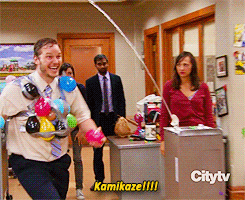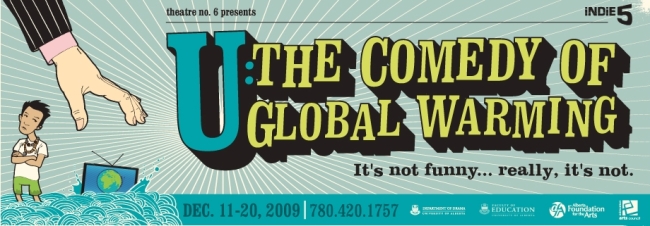I presented this paper at the Fan Studies Conference at UEA (4-5 July, 2015). The conference was excellent. Fellow On/Off Screen contributors Bertha Chin and Rebecca Williams are on the FSN board, and both Rebecca and Lori Morimoto presented papers at the conference. My attendance was funded by the Birmingham Centre for Media and Cultural Research, where I´m part of the Body Genres research cluster (formerly Screen Cultures).
I´m currently working on a larger multi-text and multi-sited study of online audience engagement with screen comedy, and in this paper I´d like to focus on one of the issues I´m exploring, which is the role of comic distance. This concept informs a lot of academic work on comedy and it´s about how comedic texts use various strategies to distance audiences from the portrayed events, so that we can laugh when things go wrong, rather than just feel sorry for characters or worry about them. To me, there seems to be a tension between this idea of distance and the attachments that fans develop to their fan objects, and so I´m interested in exploring how comedic texts also invite audience investment and how online fan responses to comedy might negotiate this push/pull dynamic. So what I want to do here is to try to unpack the notion of comic distance and to use the case study of the Tumblr-based fandom of mockdocumentary sitcom Parks and Recreation to explore how these Tumblr posts articulate different affective registers.
Theoretical framework
To clarify my own approach to understanding comedy, I think of the experience of humour as embodied and performative. This draws on Ahmed´s (2004) theory of emotions, which argues that we inscribe objects or others with certain attributes through our affective encounters. So, when I perceive a sitcom as being funny, my performance of amusement constructs the show as having the essential quality of being funny, while also constructing my own identity as a comedy viewer with particular experiences and tastes. My individual encounters with comedy are situated within a wider “affective economy” (8) of cultural discourses around what is funny and what isn´t, and within this environment my repetitive performances of amusement reinforce cultural norms (194).
But amusement is of course not the only possible feeling in responses to comedy. Screen comedy can adopt different strategies to encourage viewers to read moments as exciting, sad or romantic, for example, and I think the semiotic concept of “modality” offers a useful way in for thinking about how that happens. I´m using the definition of modality provided by Hodge and Tripp (1986), which describes it as concerning “the reality attributed to a message” by a speaker and a listener (104).
A weaker modality is signalled by excessive performances, for example, or unlikely events, and it offers comic distance by reminding us that what we are seeing is not “real”. This encourages us to relax and laugh at characters´ failures and mishaps. In contrast, a stronger modality can invite us to care about characters and get invested in their relationships. Many narrative-driven comedies, including Parks and Recreation, will use subtle and more marked modality shifts to offer viewers comic pleasures while also including moments that are positioned closer to reality in different ways, to encourage other affective responses, to follow the narrative, care about what happens, and develop emotional attachments to the show.
Data
So how were these shifts in comic distance negotiated through the fan responses on Tumblr? I collected and coded the 100 top posts tagged #Parks and Recreation about a week after the show´s final episode was shown in the US and then examined some of the blogs that were dedicated to specific characters and comedians on the show. Those of you who are familiar with Tumblr will be unsurprised to hear that the majority of posts in my sample were screenshots and animated GIFs and GIF sets, mostly with captions quoting the dialogue from those depicted moments.
Key practice: Quotation
A study by Hillman et al (2014) found that GIFs let fans post key scenes for discussion and creative reworking. In my sample, however, there was hardly any evidence of discussion. Most posts were just sharing particular moments from the show, a practice we can term quoting. This absence of analysis reproduces a cultural discourse that distinguishes between appropriate and inappropriate ways of talking about comedy. While analysis is seen to kill the joke or as taking comedy too seriously, quoting comedy stays within “the realm of humour” (Mulkay 1988: 21) and maintains comic distance. This practice is a key pleasure in comedy fandom.
Comedy quotations have traditionally entailed the spoken performance of comedic dialogue, which detaches lines from their visual context and reinforces the cultural privileging of verbal over visual humour. On Tumblr, though, the emphasis was on imagery as the screenshots and GIF sets draw our attention to performances, while also showing us costumes, sets, camera work, and so on. Within this quotation culture, posters are perhaps primarily rewarded for their ability to select textual moments or paratexts that resonate with other fans. Such resonance is indicated by the number of “notes” a post attracts, which comprises “likes” and reblogging by other users. As Abbott (2014) argues, Tumblr´s focus on “microblogging” foregrounds curation, sharing and annotation over longer, original content. And as popular #Parks and Recreation posts are shared with a widening audience, this repetition reinforces the salience of particular textual moments within that fan culture.
Affective resonances
Betz (2014) suggests that fan screenshots and GIFs can be seen as a “continuous flow of affective images” (para. 2) that enable Tumblr users to align themselves with others who have similar affective interpretations of characters. So what kinds of affective resonances were indicated by posts in my sample? Of the 100 posts I examined, 65 clearly articulated amusement, but 25 did not.
Amongst the humorous posts I found an emphasis on moments where Leslie, Andy, April and Ron are behaving in ways that reiterate key comedic character traits: Leslie is being intense, Andy is acting as a fool, April is resisting social conventions and Ron is presenting stern verdicts. However, across these expressions of amusement there also seemed to be articulations of other affective responses, such as admiration for Leslie´s commitment, for April´s rebelliousness, for Andy´s exuberance and for Ron´s snappy authority.
These compound affective responses suggest to me that, while fans might sometimes laugh “at” characters and feel superior to them, this sense of superiority is destabilised because they also inscribe those characters with value and develop attachments to them over the course of the show. And as Mills (2011) has noted, the comedian´s position of power complicates this relationship further. A particularly interesting case here is the contrast between Andy as a chubby, sweet-natured fool and actor Chris Pratt´s persona as a buff, accomplished action star, developed through the blockbusters Guardians of the Galaxy and Jurassic World. Chris Pratt´s stardom complicates readings of Andy as a buffoon. This incongruity was a focal point in Tumblr blogs dedicated to the actor, with posts frequently expressing bemusement, admiration and affection.
I think the interest in the comedian / character relationship also highlights a key issue in the push/pull relationship between comedic texts and audiences. While a comedic modality can distance us from a character´s misfortune, for example, the enjoyable sense of amusement might make us feel close to those who “gave” us that jokework or comic situation, which we might consider to be the characters but also the writers, the director or the performers, for example. We might feel a sense of shared understanding, maybe, or a sense of gratitude for the pleasurable experience. And while a comedic modality reminds us that the events we see are fictitious, it also draws attention to the “realness” of the performers and the “authenticity” of their displays of comedic skills in improvisation, comic timing and physical clowning, for example. So, comedy invites viewers to adopt reading strategies that shift between different orientations towards characters and performers (Cook 1982), which results in quite a complex interplay between proximity and distance that opens up for different kinds of emotional attachments.
Newman (2014) emphasises that what is “unquoted” is as important as what is included in quotation culture because the repeated process of selection can help form the meanings of texts. By circulating posts that focus on specific character traits, fans co-create a hierarchy of characters and inscribe certain traits with value. It is notable that Chris, Tom, Donna, and Gerry were peripheral in the #Parks and Recreation posts, despite some of them featuring prominently in the show. In contrast, Ben and Ann were only occasionally the sole focus of humorous posts but more frequently included in posts about their relationships with Leslie. I think this indicates the value placed on “shipping” and what we might call “friendshipping” in this fan culture.
While shipping often involves conflicts between groups of fans who support different romantic relationships, here there was a focus on the friendships between Leslie / Ron and Leslie / Ann as well as the two most stable romances in the show, which are April / Andy and Leslie / Ben. Both of these romantic couples meet, date, marry and have children over the course of the sitcom and there was no evidence of fans shipping these characters with alternative partners. This shipping practice, then, should be situated within the stability of the sitcom genre, where viewers tend to expect a happy ending. So while Ann leaves the show in season 6, her return for the show finale cements hers and Leslie´s friendship.
Interestingly, there was no evidence of fans shipping the romance between Ann and Chris, although they date briefly and are later reunited and have a baby. I suspect the marginalisation of this ship in the fan culture is a result of the way it is cued in the show. While the representations of the Andy / April and Ben / Leslie relationships do function as sources of humour, they also encourage viewers to invest in those romances through occasional shifts to more complex modalities (King 2002: 13) that position them closer to reality and invite “[a]ffective implication” (Purdie 1993: 85). The resonance of such moments were indicated by several posts in my sample, which included quotations of Ben´s proposal to Leslie and his suggestion that they start a family, as well as quotations of April expressing her love for Andy and giving him encouragement when he was worried about his job.
In contrast, the romance between Ann and Chris is nearly always cued as comedic in the show. While Ann is usually the “straight” character that we see reacting to the comic behaviour of other characters, Chris is represented through a modality of comic excess. His absurdly exaggerated behaviour invites audiences to feel superior to him, and the disparity between him and Ann constructs their relationship as a comic incongruity. This maintains the comic distance between the couple and the viewers, hindering the intense emotional investment or “feels” that is a key pleasure in shipping (Hillman et al 2014: 7).
Conclusion
So, to sum up, I think the push/pull strategy of comedic texts can be usefully examined through the concept of modality, through the idea of fans inscribing characters with value through affective encounters, and by thinking about how comic distance invites proximity to performers and other creative personnel. Approaching quotation posts on Tumblr as articulations of affective resonance, I found a marked emphasis on the expression of amusement at key character traits, along with feelings of admiration and affection, which complicates the idea that we are laughing at characters because we feel superior to them and indicates fan attachments.
I also identified a focus on the shipping of friendships and romantic relationships that are represented through shifting modalities within the text, and an absence of shipping of a romance that is cued primarily as comedic in the show. Finally, it´s worth noting that even shipping posts were overwhelmingly in the form of quotations, rather than discussion, which suggests that even though comedies can use textual strategies to decrease comic distance and invite audience investment, the notion of comic distance might still inform our understanding of appropriate ways to articulate such investment.
References:
Abbott, Daisy (2014) “Old plays, new narratives: fan production of new media texts from broadcast theatre.” In Huson Moura, Ricardo Sternberg, Regina Cunha, Cecilia Queiroz and Martin Zeilinger (eds) Proceedings of the Interactive Narratives, New Media & Social Engagement International Conference. http://interactiveconference.spanport.utoronto.ca/resources/InteractiveNarratives-proceedings.pdf
Ahmed, Sara (2004) The Cultural Politics of Emotion. Edinburgh: Edinburgh University Press
Betz, Stephanie (2014) “Affective Moorings: The Online Sociality of Fandom”. ASAANZ/AAS Conference, Queenstown, 20-13 November.
Cook, Jim (1982) ‘Narrative, comedy, character and performance’. In J. Cook (ed.) BFI Dossier 17: Television sitcom. London: BFI, pp. 13-18
Hillman, Serena, Procyk, Jason and Neustaedter, Carman (2015) “‘alksjdf;lksfd’: Tumblr and the Fandom User Experience”. DIS ’14 Proceedings of the 2014 conference on Designing interactive systems, pp. 775-784. h
Hodge, Robert and Tripp, David (1986) Children and Television: A Semiotic Approach. Stanford: Stanford University Press
King, Geoff (2002) Film Comedy. London: Wallflower
Mills, Brett (2011) “‘A pleasure working with you’: Humour theory and Joan Rivers”. Comedy Studies 2(1): 151-160
Mulkay, Michael (1988) On Humor: Its Nature and its Place in Modern Society. Cambridge, UK: Polity
Newman, Michael (2014) “Say ‘Pulp Fiction’ One More Goddamn Time: Quotation Culture and an Internet-Age Classic”. New Review of Film and Television Studies 12(2): 125-142
Purdie, Susan (1993) Comedy: The Mastery of Discourse. New York: Harvester Wheatsheaf




